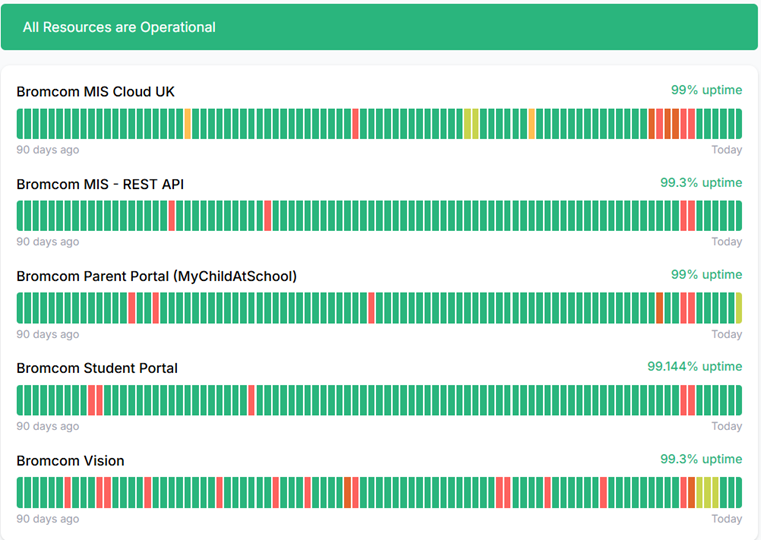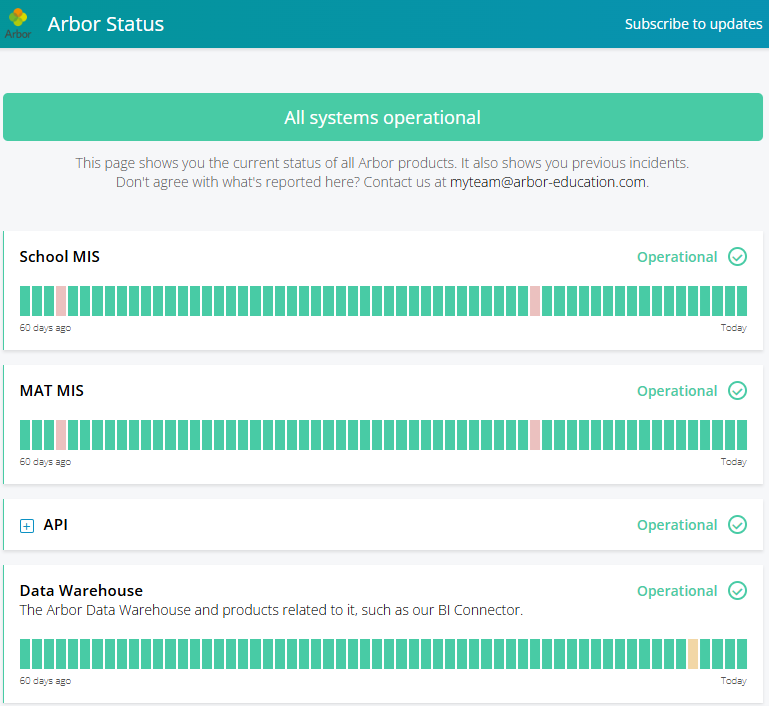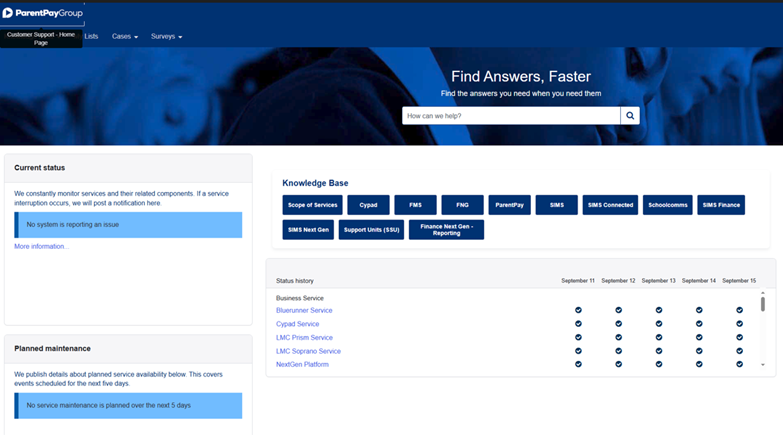The recent outage of Bromcom’s cloud-based MIS platform has reignited a critical conversation in the education sector: how prepared are schools and trusts for digital disruption?
Between September 4th and 9th, hundreds of schools experienced severe service degradation, with some reporting total system failure. The timing at the beginning of the new academic year amplified the impact.
Attendance tracking, safeguarding alerts, timetable access, and financial workflows were all affected. For many, the outage wasn’t just inconvenient—it was operationally paralysing.
Bromcom Status Page:
Dated Monday 15th September

Outage in cloud services will happen sometimes – see attached image of other names with the recent outage incidents.
For comparison, below is a screen grab of the equivalent Arbor status page:

ESS SIMS does also have a Hosted Service Status page, but it is not public facing:
SIMS Status Page for SIMS Connected: SIMS – ESS SIMS Hosted Services Status Page (support-ess.com)

Beyond the Error Messages
While Bromcom has since stabilised its platform and issued a formal apology, the incident exposed a deeper issue: the fragility of core school functions when tethered to a single digital system. One trust leader described the experience as “chaotic,” with staff working outside contracted hours to manually bridge gaps left by the outage. Another school postponed extracurricular activities due to booking failures, while finance teams faced reputational pressure from unpaid suppliers.
We asked Bromcom for their comments and received this response:
We sincerely apologise for the disruption some of our customers experienced with our platform earlier this month. We recognise that our MIS is a critical system for schools and that safeguarding must never be compromised. We deeply regret the additional strain this placed on staff, pupils, and the wider community at the start of term.
The platform has now been stable for the past week, and we continue to closely monitor performance. Alongside this, we are implementing further resilience improvements and working with our infrastructure partner to strengthen protection against future disruption.
An interim Root Cause Analysis has already been shared with our customers, and we will continue to communicate openly with all stakeholders as our work progresses. A full RCA will follow, with clear actions to prevent recurrence.
While outages can affect all cloud providers, we recognise that downtime in a school MIS has a uniquely significant impact. With this in mind, we are investigating additional contingency measures to support schools in the event of any type of failure—whether caused by infrastructure, connectivity, or external factors. Our goal is to provide the most resilient, wrap-around MIS service available.
We remain grateful for the extraordinary efforts of school staff during this period and reaffirm our commitment to keeping the community updated through our status page, emails, customer calls, and other channels.
Simon Walters, Chief Operating Officer
Mark Wilson, Chief Technology Officer
The most important aspect is how the vendor (in this case Bromcom) handles the comms and eradicates the root cause. But also that the vendor build on that experience for even more improved services and robust resilience. Users may also see this as a check point to ensure they have processes that deal with outage – whether paper or otherwise.
These aren’t just technical hiccups—they’re mission-critical failures that ripple across safeguarding, parent communication, and staff wellbeing.
It’s not just MIS platforms either
Many of the biggest names in cloud computing have suffered significant outages this year. These include Microsoft 365, Google Cloud, IBM, Zoom, Slack, asana and many others too.
Initial data suggests that IT teams simply have more on their plates than ever, and at the same time ever more users are accessing these platforms, putting more pressure on infrastructure.
A Pattern Emerging?
This isn’t the first time schools have faced disruption at the start of term. Some leaders noted similar instability last year, raising concerns about recurring vulnerabilities. Whether coincidental or systemic, the pattern suggests a need for sector-wide reflection on digital risk management.
Rethinking MIS Strategy
Bromcom’s market share has grown significantly, now estimated at 16%, with turnover reaching £32 million in 2024. As cloud-based MIS platforms become the norm, their reliability becomes non-negotiable. Consultant Nick Finnemore, formerly of SIMS, warns that schools must build resilience into their processes: “For high-risk tasks, there must be a way to continue without sole reliance on the MIS.”
This isn’t a call to abandon digital systems—it’s a call to diversify operational safeguards. Offline attendance registers, parallel safeguarding logs, and contingency workflows may seem old-fashioned, but they’re increasingly vital.
What Comes Next?
Bromcom has committed to a full root-cause analysis and pledged to restore confidence in its platform. But for schools, the bigger question is strategic: how do we balance innovation with resilience? How do we ensure that when systems stall, learning—and safety—don’t?
Building MIS Resilience—Five Contingency Tips for School Leaders
- Safeguarding First Maintain a parallel log for safeguarding concerns—whether via secure spreadsheets or encrypted offline forms. Ensure DSLs can access and escalate issues without relying solely on the MIS.
- Attendance Backup Protocols Equip staff with printable registers and manual tally sheets. If digital tracking fails, schools should still be able to identify absentees and trigger home visit thresholds.
- Finance Fallbacks Prepare a basic supplier ledger outside the MIS. Track pending invoices and payments manually to avoid reputational damage during outages.
- Timetable Access Offline Export and distribute timetables weekly in PDF or printed formats. Staff and students should have access even if the MIS is down.
- Communication Channels Establish alternative parent contact systems—SMS platforms, email groups, or even emergency phone trees. When MIS-linked alerts fail, schools must still be able to reach families.
How UK MIS Providers Stack Up on Transparency and Resilience
As the Bromcom outage reminded us, a slick interface and feature-rich MIS mean little when the system isn’t available.
With schools increasingly reliant on cloud-based platforms, the conversation is shifting—from “What can this MIS do?” to “How well does it hold up under pressure?”
Disaster Recovery Protocols: What’s Known?
Public documentation on disaster recovery is sparse. Bromcom acknowledged a server fault and committed to a root-cause analysis, but details remain pending. Arbor, SIMS, and others do not publish disaster recovery plans or business continuity frameworks for school clients.
This lack of visibility makes it difficult for schools to assess risk or compare providers on resilience. As one consultant put it: “Schools need to know not just what happens when things go right—but what happens when they don’t.”
What Schools Should Ask Providers
Before signing or renewing MIS contracts, consider asking:
- Do you publish real-time system status and uptime metrics?
- What’s your disaster recovery protocol—and how often is it tested?
- How quickly can core functions (attendance, safeguarding, finance) be restored after an outage?
- Will you notify us of incidents proactively, and share root-cause findings?
Commentary: The Outage We Can’t Ignore
The MIS market is evolving fast, with Arbor and Bromcom gaining ground. But growth must be matched by accountability. Schools deserve more than feature lists—they need reliability, transparency, and a clear plan for when things go wrong.
The Bromcom incident isn’t just a technical failure—it’s a sector-wide stress test. As cloud-based MIS platforms become central to school operations, we must ask: are we building systems that serve us only when they work perfectly?
Contingency planning isn’t a luxury—it’s a leadership responsibility. Schools that treat digital infrastructure as infallible risk being blindsided. Those that prepare for failure build trust, continuity, and resilience.
At WhichMIS.com, we believe the future of MIS isn’t just about features—it’s about reliability, transparency, and the ability to adapt when things go wrong.
We’ll continue tracking not just what providers offer, but how they perform when it matters most.

